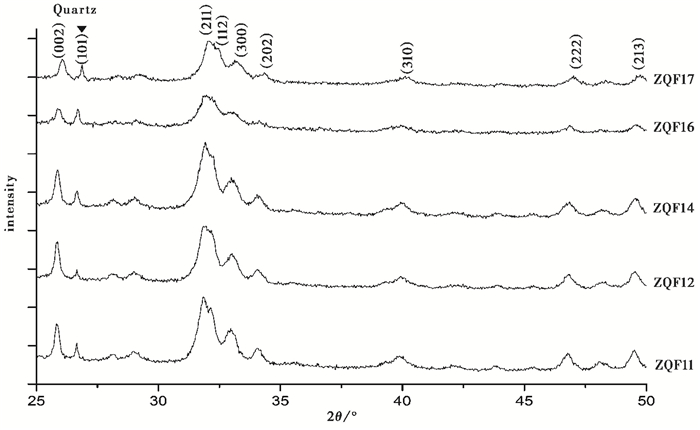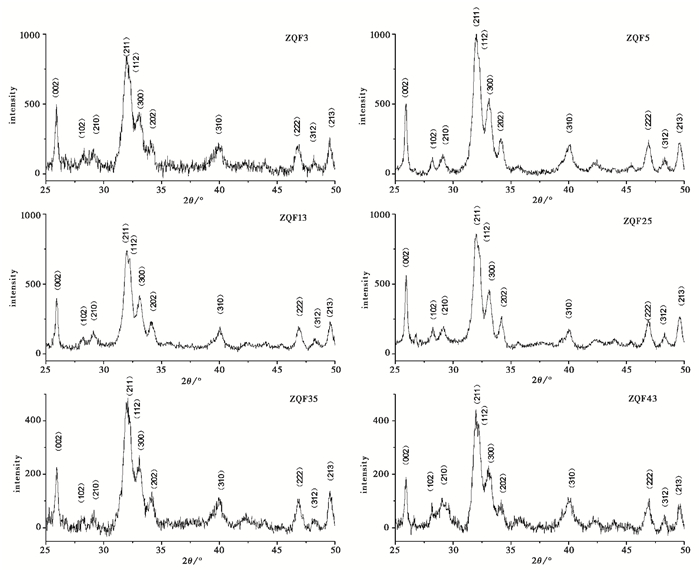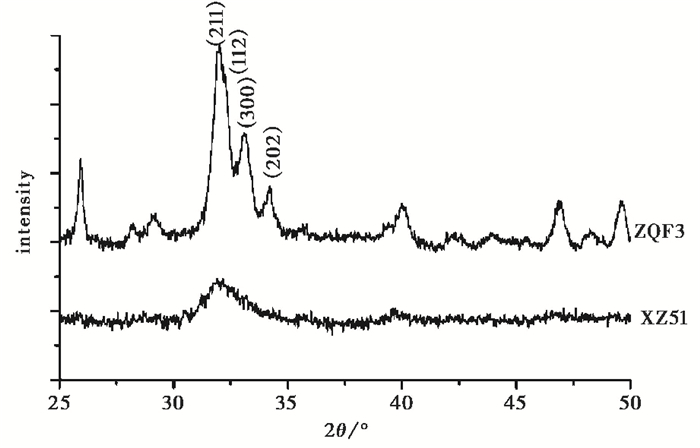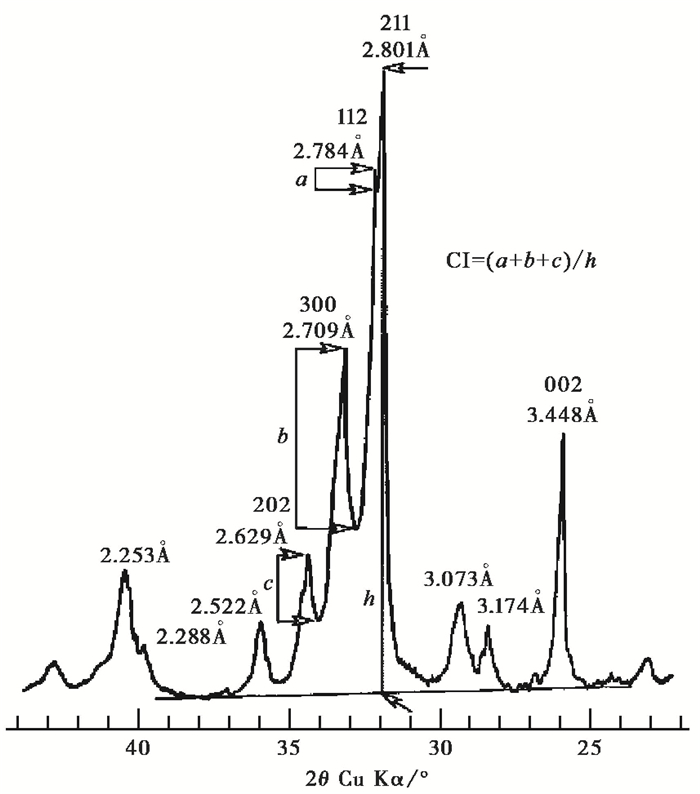② 中国科学院古脊椎动物与古人类研究所, 中国科学院脊椎动物演化 与人类起源重点实验室, 北京 100044;
③ 中国科学院大学人文学院, 科技史与科技考古系, 北京 100049;
④ 浙江省文物考古研究所, 杭州 310014;
⑤ 南开大学历史学院, 考古学与博物馆学系, 天津 300350)
自20世纪70年代末起,通过考古遗址中人(动物)骨的稳定同位素分析,揭示先民(动物)的食物结构,探索先民的生活方式及其演变、人群的迁徙、农业的起源与演进、动物的驯养方式,已成为生物考古研究中必不可少的研究领域之一[1~10]。然而,纵观国内外稳定同位素分析的研究对象,主要集中于骨中的有机质部分(骨胶原),对于骨中的无机质(羟磷灰石),是否也可开展稳定同位素分析,仍存在相当大的争议。
这一争议其实是羟磷灰石能否成为14C测年法测年对象的延续[11]。自20世纪50年代14C测年法被广泛运用于考古学实践起[12],骨胶原一直是最主要的测年材料之一[11];而羟磷灰石则由于污染问题一直颇受争议[13, 14]。在这一领域曾做出巨大贡献的Krueger[15]在1965年就提出:“对于被地下水污染过的骨骼样品,我们只能利用它的有机质部分来测年。骨骼的无机质部分是毫无用处的。”在当时,受14C测年技术启发而开展的稳定同位素食谱研究也面临同样的问题,一部分学者认为人(动物)骨骼中羟磷灰石的化学组成与本体生前的食物结构密切相关,当食物被人体吸收后,碳稳定同位素在骨骼羟磷灰石中会产生富集效应,羟磷灰石能用来进行古食谱的重建研究[16~19];而另一部分学者则提出骨骼在埋藏过程中会受到二次污染,这些污染在预处理过程中很难被消除,所以羟磷灰石中的碳含量并不能准确地反映古人生前的食物结构,其在古食谱重建中的作用不大[20, 21]。
然而,在利用骨骼中的骨胶原进行测年和古食谱分析时[22~24],辨析样品的污染情况也是后续讨论的前提条件之一,尤其在一些热带/亚热带地区,由于地下水位过高[24]、微生物侵蚀以及高温[22]等环境因素,大部分骨胶原都流失了,极大限制了对这些地区骨骼的埋藏状况、测年、古食谱等的研究进展;在我国,特别是在新石器时代的食谱研究中,也主要利用骨骼骨胶原讨论北方原始粟作农业(包括种植业与家畜饲养业)的起源与发展[25~28],对南方地区涉及较少[29~32],这与南方地区骨胶原保存情况不佳有着密切关系。
近年来,为了推动热带/亚热带地区的骨骼测年研究,学者们重新思考能否利用骨骼中的无机质部分(羟磷灰石)作为实验样品,并将研究焦点集中在骨骼污染鉴别方法的建立上。研究结果显示,通过选择合适的污染鉴别方法、设计合理的样品预处理方法[33, 34],可以有效地判别羟磷灰石是否受到了成岩作用的影响。在此基础上利用羟磷灰石进行骨骼测年,其可靠性和准确性大大增加[35, 36]。而这一结果也为利用羟磷灰石研究全球热带/亚热带地区先民食谱问题带来了福音--越来越多的实验数据证明了通过羟磷灰石中的碳稳定同位素重建古人食谱的可行性[37~39]。
正因如此,对羟磷灰石保存情况、污染情况的分析和研究就成为了探索我国南方热带/亚热带地区古人食谱状况的重要突破口[40]。本文拟以良渚文化浙江庄桥坟遗址出土的人和动物骨骼为研究对象,运用元素分析仪、X射线衍射(XRD)、红外光谱(FTIR)等现代分析手段,从骨胶原和羟磷灰石两方面分析庄桥坟遗址骨骼的保存情况和污染情况,尝试建立一种简单而有效的污染鉴别方法,为利用骨骼中的羟磷灰石在中国南方地区开展食谱研究工作奠定基础。
2 骨骼污染研究 2.1 污染原理根据生物考古理论,骨基质主要由有机质(90 %以上为骨胶原)和无机质(绝大部分为羟磷灰石)组成[41]。骨骼的污染(骨骼成岩作用)主要表现为羟磷灰石的污染或骨胶原的流失[42]。生物体上的羟磷灰石结晶度较差,较易与外界离子发生取代、置换、吸附、扩散、迁移等作用而改变晶体结构[43, 44]。骨骼中胶原蛋白的污染主要是由于在长期埋藏过程中多肽链逐渐发生分解和降解,改变了起初的氨基酸组成。显然,上述发生污染的骨骼已不再保持其原先的元素组成,不能直接反映古代人类的食谱信息。
2.2 污染鉴别方法骨骼污染的具体鉴别方法,主要从分析骨胶原的变化、羟磷灰石的结构等方面进行。
判断骨胶原是否污染的最重要的指标,当属骨胶原的C/N摩尔比值,DeNiro等[45]通过一系列的对比实验和模拟试验认为比值在2.9~3.6之间,则骨胶原保存较好,可用于食谱重建分析;小于2.9或大约3.6则已经不是真正意义上的骨胶原,而是在死后的受热或成岩作用下产生的新的有机体,其δ13C和δ15N的信息已经改变,如用这些数据进行食物结构分析,会导致错误的结果。
而通过分析羟磷灰石的结构探讨其污染问题,可以运用多种实验方法,例如拉曼光谱[46]、电感耦合等离子体质谱(ICP-MS)[47]等。目前较为通行的办法是X射线衍射(XRD)与红外光谱分析(FTIR)相结合[37,44,48,49]。XRD是目前研究晶体结构和进行物相分析的最成熟、最有效的方法[50~53],利用XRD可以判断样品中羟磷灰石的结晶度和晶体结构是否发生了变化;与此同时,FTIR不仅可以展现样品的晶体结构以及化学组成[54, 55],还可以判断样品中各分子基团的含量及其变化;通过对FTIR图谱中CO32-和PO43-的多个特征性吸收峰及其强度的定性及半定量分析,构成多种指数来指示羟磷灰石结晶度和有序程度以及成分的变化,可以推断样品受成岩作用的影响程度[44]。
3 材料与方法 3.1 研究地区概况和样品选择庄桥坟遗址位于浙江省平湖市东南部林埭镇群丰村,向南5km即是杭州湾,其地理坐标约为30°40′N,120°35′E,属于亚热带季风性气候区。考古人员分别于2003年和2006年对庄桥坟遗址进行了发掘,发现了目前为止最大的良渚文化墓地,年代约为距今3700~5000年[56, 57]。考古发掘清理了良渚文化中晚期墓葬271座,以及灰坑、沟、祭祀坑等遗迹近100处,出土各类遗物近3000件(组),还有大量的动植物遗存。本次研究选择了庄桥坟遗址50例骨骼样品(编号ZQF1~ZQF50),其中人骨37例,动物骨骼13例;并选取一块现代猪的股骨作为对照样品(样品编号为XZ51)。
3.2 样品制备(1) 制备骨胶原:机械加工去除骨样表面污染后,取300~500mg骨样放入0.5mol/L的HCl溶液,于5℃的环境下静置脱钙,每2~3天换新鲜酸液,直至骨样松软,溶液无明显气泡为止。去离子水清洗至中性,在0.001mol/L的微酸环境下70℃明胶化48小时,热滤,经Millipore Amicon Ultra -4超滤后收集分子量 > 30K的溶液,冷冻干燥后获得骨胶原,称重并计算骨胶原产率(骨胶原重量/骨样重量)(样品编号为ZQF1~ZQF50)。
(2) 羟磷灰石的古代样品处理:由于考古样品量的限制,骨胶原实验完成后,只余44例样品进行羟磷灰石的实验分析(除去ZQF1、ZQF2、ZQF19、ZQF34、ZQF38和ZQF50)。用手术刀和打磨机机械去除这44例样品内外表面的污染物,放入超声波清洗仪中10分钟,烘干后用玛瑙研钵进行研磨。取30mg样品首先用2 %次氯酸钠溶液在4℃下浸泡1~2天,清除外源性的有机污染物,然后用去离子水清洗3次。为了去除埋藏过程中产生的次生碳酸盐,在4℃环境下,将剩余的粉末浸泡于1mol/L的醋酸溶液中约24小时。用去离子水清洗3次,最后进行冷冻干燥,备用。
(3) 羟磷灰石的现代对比骨样处理:去除附在骨上的残余肉及皮质,放入超声波清洗仪中10分钟,除去血污等杂物。去除附在内表面的骨髓部分,切割成碎片,用玛瑙研钵研磨成粉末,装入称量瓶,密封备用(样品编号XZ51)。
3.3 测试分析 3.3.1 元素分析仪-同位素比值质谱仪(EA-IRMS)检测于元素分析仪-同位素比值质谱仪(EA-IRMS)上测试骨胶原C、N含量及同位素比值。C同位素的分析精度为±0.1 ‰,N同位素的分析精度为±0.2 ‰。C同位素的分析结果以相对V-PDB的δ13C表示,而N同位素比值相对于空气或空气中的氮气以δ15N (AIR)表示。
3.3.2 X射线衍射(XRD)分析X射线衍射:仪器为D/max-rA型转靶X射线衍射仪。工作条件:电压、电流分别为40kV和100mA,DS、SS和RS依次为1°、1°和0.15mm,衍射角范围是10°~60°。
3.3.3 红外光谱分析(FTIR)采用VECTOR 22傅里叶变换红外光谱仪进行分析。KBr压片法,取3mg样品。与300mgKBr混合进样,检测范围4000~400cm-1,分辨率1cm-1。
4 结果与讨论 4.1 骨胶原保存状况分析 4.1.1 从骨胶原含量分析骨胶原保存状况在本研究的50例古代人(动物)骨骼样品中,20例无法提出骨胶原,说明其骨胶原在埋藏过程中已经完全流失。在其余的30例样品中,骨胶原提取率的变化范围为0.03 %~0.68 %,均值为0.22±0.20 %,可见即使是可以提取骨胶原的30例样品,其骨胶原含量也很低(表 1),远低于现代骨中的骨胶原含量(20 %左右)[58],表明大部分骨胶原在长期的埋藏过程中已遭到分解。
4.1.2 从C、N含量分析骨胶原保存状况当骨骼发生污染,其有机成分骨胶原将在各种因素的影响下发生降解,C、N元素含量也随之降低[15, 19]。因此,骨胶原中C、N含量可作为衡量骨胶原保存状况的指标之一。现代骨胶原的C含量约为41 %,N为15 %[59]。从表 1可以看出,30例可以提出骨胶原的样品中,仅有ZQF13一例同时含有C、N元素,且含量较低(C为2.95 %,N为0.57 %)。仅有8例含有N元素,N含量均值为0.25±0.14 %。极低的C、N元素含量表明本研究中部分样品虽有骨胶原保存下来,但残存的骨胶原也在长期的埋藏过程中受到不同程度的降解或污染。
| 表 1 庄桥坟遗址人骨、动物骨样品骨胶原测试数据 Table 1 Information and isotopic data of human and animal bone collagen samples in the Zhuangqiaofen site |
判断骨胶原是否污染的最重要指标,当属骨胶原的C/N摩尔比值,DeNiro等[45]通过一系列的对比实验和模拟试验认为比值在2.9~3.6之间,可认为骨胶原保存较好,可以用于食谱重建分析。本研究中,只有ZQF13一例样品的骨胶原同时含有C、N元素,经计算,其C/N摩尔比为5.96,超出了2.9~3.6的范围,且与现代样品的C/N比值3.2[59]相差甚远,表明ZQF13也是被污染的样品,不能进行后续的食谱分析。
4.1.4 原因分析通过测量庄桥坟遗址50例人(动物)骨骼骨胶原的提取率、C含量、N含量、C/N摩尔比,可以发现样品骨胶原提取率、C含量、N含量均很低,C/N摩尔比超出正常范围,有效样品率为0 %。
已有的研究表明高温、充足的地下水、湿热的气候环境、酸性土壤等外部埋藏条件均会对骨骼中骨胶原的保存产生直接或间接的破坏[22, 60, 61],在骨胶原降解的过程中,某些特定氨基酸会优先流失[62],由于骨胶原中不同氨基酸的C、N含量不同,因此氨基酸流失的不均衡性最终导致了C、N同位素比值的改变[63]:如细菌作用会优先破坏C含量丰富的氨基酸,破坏骨胶原的完整性,造成C、N含量的失衡[64]。庄桥坟遗址样品不仅骨胶原提取率低,且残存的少量骨胶原C、N流失严重,C/N摩尔比值异常暗示骨胶原中特定氨基酸流失不成比例、骨胶原的氨基酸组成已经发生改变。这种情况是与该遗址所处环境密切相关。庄桥坟遗址位于杭嘉湖平原东北部,属北亚热带季风性气候,四季分明,降雨量充沛,河网密布[56, 65~67],土壤主要以水稻土和盐土为主[68]。这种潮湿多雨、土壤酸性较强的环境,不利于骨胶原的保存。
4.2 羟磷灰石保存状况分析庄桥坟遗址人(动物)骨骼骨胶原保存情况分析表明,骨骼中的有机质(骨胶原)已经完全被污染,无法展开后续食谱研究;而检测骨骼中的无机质(羟磷灰石)保存情况是否良好,则成为后续食谱分析的唯一选择。
4.2.1 羟磷灰石X射线衍射分析骨胶原实验完成后尚余44例样品,对这44例样品进行XRD检测,发现有14例样品的图谱中除含有羟磷灰石特征峰之外,在(101)还有一处较明显的特征峰(图 1,部分图谱略),经PDF标准数据检索为石英、钠长石和钾长石,表明这14例骨样应为污染样品,不能进行后续分析;其余30例样品,如ZQF3、ZQF5等的羟磷灰石主要特征衍射峰明显,且不含其他杂质(图 2,部分图谱略),说明其羟磷灰石历经几千年的埋藏过程后仍然得以保留,符合后续分析的要求。

|
图 1 部分污染骨样XRD图谱 Fig. 1 XRD spectrum of some contaminated bone samples |

|
图 2 部分未受污染样品的XRD图谱 Fig. 2 XRD spectrum of some uncontaminated bone samples |
不同于矿物学上的羟磷灰石,骨骼中的羟磷灰石具有特有的生物学性质,其结晶度较差,晶体尺寸在c轴方向上为15~79nm,a轴方向仅为5nm。除晶体羟磷灰石以外,骨骼中还含有一定量的非晶体羟磷灰石[43]。
现代猪骨XZ51样品XRD结果显示其羟磷灰石(002)晶面的衍射峰较为宽化,强度较小;(211)、(112)、(300)晶面的衍射峰严重宽化,连接成一体成为漫射峰,表明现代骨样中羟磷灰石的结晶度较差(图 3)。这是由于新鲜骨中的非晶体羟磷灰石含量较高,致使骨羟磷灰石的总体上表现出弱结晶状态。

|
图 3 部分骨样XRD图谱 Fig. 3 XRD spectrum of bone samples |
以ZQF3为代表的30例不含石英、长石杂质的古代骨样(图 3),(211)、(112)、(300)、(202)晶面衍射峰明显,特征峰的强度关系为(211) > (112) > (300) > (202),符合羟磷灰石的基本特征。其结晶度较现代骨样明显增加,这是由于人体骨骼在埋藏过程中非晶态的羟磷灰石逐渐转变为晶体结构,导致结晶度的增加[69]。
而对羟磷灰石的结晶程度进行半定量分析,可以更准确的判断骨样的保存情况。依据标准羟基磷灰石XRD图谱(图 4)中晶面(211)峰与(112)、(300)、(202)峰的强度之比可得到结晶度指数CIxrd,其计算表达式为CIxrd=∑{H[202],H[300],H[112]}/H[211]=(a+b+c)/h[70],其中a为样品XRD分析结果中羟基磷灰石晶面(202)峰高,b为晶面(300)峰高,c为晶面(112)峰高,h为晶面(211)峰高。
30例不含石英、长石杂质骨样中羟磷灰石的CIxrd值如表 2所示,变化范围为0.23~0.71,均值为0.45±0.12(n=30),表明骨样的结晶度存在个体差异,即使在同一遗址,埋藏环境相似的骨样,保存情况也不尽相同。研究表明CIxrd与骨样中的CO32-含量呈负相关关系[70]。因此,CIxrd越小表明其保存状况越好,建议今后可以采用CIxrd指数低的骨样进行后续的羟磷灰石骨化学分析。
| 表 2 样品的CIxrd值及FTIR指数值 Table 2 CIxrd and FTIR index of bone samples |
将不含石英、长石杂质的30例样品进行红外光谱分析,所得样品的图谱如图 5所示(以ZQF18为例)。CO32-的ν2和ν3振动带均出现于样品中[71]。现代生物磷灰石主要有约1544cm-1、1457cm-1、1415cm-1等3个峰,表明CO32-同时取代了OH-和PO43-。所有的样品图谱中都出现了这3个峰,约1544cm-1强度较弱,约1457cm-1和1415cm-1强度较高,与现代生物磷灰石类似[17, 19]。所有样品的图谱中PO43-和CO32-振动带明显,并且没有发现其他杂质的吸收峰,例如710cm-1是方解石的特征峰,1096cm-1是细晶磷灰石的特征峰[72]。

|
图 5 ZQF18骨骼样品的FTIR图谱 Fig. 5 FTIR spectrum of sample ZQF18 |
此外,基于FTIR中的CO32-和PO43-的多个特征性吸收峰及其强度的定性及半定量分析,可以构成多种指数,来分析羟磷灰石结晶度以及成分的变化,由此推断受成岩作用的影响程度[71],其中较为常用的是PCI (Phosphate Crystallinity Index)、BPI (B-carbonate on Phosphate Index)和C/P (CO32-/PO43-)。
PCI:指PO43-在565cm-1和605cm-1吸收峰强之和与两峰之间590cm-1谷峰强之比值[73],其范围值可以大致判断样品是否受到了污染。现代骨骼样品的PCI指数大约为2.8~3.0,考古学出土样品则大约在3.5~4.8左右;一般而言,PCI指数如果高于4.3,则说明这一样品已经发生了重结晶,保存状况较差[73]。
BPI:指v3CO32-在1415cm-1和v4PO43-在605cm-1处的吸收峰强之比[74]。利用BPI可以估算出羟磷灰石中CO32-含量(%):10×BPI+0.7。现代骨骼样品约含有7.4wt. % CO32-,牙齿约含有3.5wt. % CO32-[74]。在预处理之后,样品中BPI的值可能会降低。Webb等[72]曾测试过酸处理对样品的影响,发现处理之后样品的BPI下降了0.3,而PCI和C/P并没有显著变化。
C/P:指v3CO32-在1415cm-1和v3PO43-在1035cm-1处的吸收峰强之比[75]。一般而言,如果考古学样品的C/P较低,说明其在埋藏环境中CO32-发生了流失的现象;如果C/P值较高,说明出现了次生碳酸盐的堆积[75]。
对不含石英、长石杂质的30例样品进行FTIR指数分析,结果如表 2所示。将其与其他研究所得的FTIR指数进行比较分析后发现(表 3),本研究中30例样品的PCI在2.98~4.16之间,平均值为3.55±0.28(n=30),低于4.3,且与其他遗址出土的样品PCI值相当,说明样品的结晶度较低,受成岩作用影响小;30例样品的BPI值在0.41~0.62之间,平均值为0.49±0.06(n=30),说明CO32-含量在4.8 %~6.9 %之间,这一数值低于现代样品中CO32-含量(7.4 %),与其他遗址相比也较低,这可能说明了在埋藏过程中,CO32-含量有一定程度的流失,也有可能是预处理中的醋酸分解了样品中的弱结晶盐所引起的;C/P值在0.11~0.27之间,平均值为0.16±0.03(n=30),与现代样品和其他遗址的古代样品大致相当。
| 表 3 FTIR指数分析 Table 3 Analysis of FTIR index |
由以上分析可知,PCI和C/P的数值处于正常范围内,而BPI的数值相对较低。为了讨论较低的BPI是否会对羟磷灰石保存情况造成影响,需要对三者之间的相关性进行分析(图 6)。一般而言,BPI与C/P、BPI与PCI、PCI与C/P之间的相关性越显著,骨骼的保存情况越好[75];分析结果表明30例样品的PCI与BPI具有相关性,C/P与PCI有较强的负相关性,而与BPI具有较强的正相关性。这三者之间较强的相关性暗示这30例样品虽然BPI值较低,但是其中的CO32-依旧得到了较好的保存。

|
图 6 FTIR指数的相关性分析 Fig. 6 Correlation analysis of FTIR index |
本文以良渚文化浙江庄桥坟遗址出土的人和动物骨骼为研究对象,运用元素分析仪、X射线衍射仪、红外光谱仪等仪器,从骨胶原和羟磷灰石两方面,对庄桥坟遗址骨骼的保存情况进行分析。本研究的结论有如下几点:
1) 浙江地区良渚文化庄桥坟遗址骨骼样品的骨胶原已经全部降解或被污染,不能再以这些样品的骨胶原为基础进行食谱分析;
2) 挑选44例样品进行XRD检测,结果表明其中有14例样品含有石英等杂质,说明样品的晶体结构在埋藏过程中很可能发生了变化,不能成为古食谱分析的材料。剩余的30例样品则不含石英、长石等杂质;
3) 将不含杂质的30例样品进行FTIR实验,结果表明所有样品的羟磷灰石特征峰明显,且不含其他杂质的特征吸收峰,说明样品受成岩作用影响小。引入PCI、BPI、C/P等FTIR指数进行半定量分析、并在指数间进行相关性分析后进一步证实样品的保存状况较好,可以用于今后的稳定同位素研究。
当然,限于遗址单一、样品数量有限,本文只对庄桥坟遗址骨骼保存状况做了初步分析。在后续研究中我们一方面将选取南方地区更多遗址的样品,另一方面也将尝试更多的检测手段从更多元的角度进行检测分析,力图更全面深入的探讨南方地区骨骼保存状况问题。同时,我们将进一步分析样品中羟磷灰石的C、O元素是否受到污染,试图通过羟磷灰石分析古人食谱结构,为丰富南方地区生物考古研究提供新的证据。
致谢: 感谢浙江大学材料系翁文剑教授、黄晓笑;中国科学院大学科技史与科技考古系胡耀武教授;浙江大学文物与博物馆学系张晖副教授、俞博雅、董艳芳、周杉杉等在本文的实验设计及写作过程中给予热情帮助!感谢审稿专家和编辑部杨美芳老师建设性的审读意见。
| 1 |
Dupras T L, Schwarcz H P. Strangers in a strange land:Stable isotope evidence for human migration in the Dakhleh Oasis, Egypt. Journal of Archaeological Science,2001, 28 (11) : 1199~1208.
doi:10.1006/jasc.2001.0640 ( 0) 0)
|
| 2 |
Hu Yaowu, Hu Songmei, Wang Weilin, et al. Earliest evidence for commensal processes of cat domestication. Proceedings of the National Academy of Sciences of the United States of America,2014, 111 (1) : 116~120.
doi:10.1073/pnas.1311439110 ( 0) 0)
|
| 3 |
Ambrose S H, Butler M B, Hanson B D, et al. Stable isotopic analysis of human diet in the Marianas Archipelago, Western Pacific. American Journal of Physical Anthropology,1997, 104 (3) : 343~361.
doi:10.1002/(ISSN)1096-8644 ( 0) 0)
|
| 4 |
Makarewicz C A, Sealy J. Dietary reconstruction, mobility, and the analysis of ancient skeletal tissues:Expanding the prospects of stable isotope research in archaeology. Journal of Archaeological Science,2015, 56 : 146~158.
doi:10.1016/j.jas.2015.02.035 ( 0) 0)
|
| 5 |
M rseburg A, Alt K W, Knipper C. Same old in Middle Neolithic diets?A stable isotope study of bone collagen from the burial community of Jechtingen, Southwest Germany. Journal of Anthropological Archaeology,2015, 39 : 210~221.
doi:10.1016/j.jaa.2015.04.001 ( 0) 0)
|
| 6 |
尹若春, 张居中, 杨晓勇. 贾湖史前人类迁移行为的初步研究--锶同位素分析技术在考古学中的应用. 第四纪研究, 2008, 28 (1) : 50~57.
Yin Ruochun, Zhang Juzhong, Yang Xiaoyong. Preliminary study of prehistoric human migration based on Sr isotope analysis from Jiahu relics. Quaternary Sciences,2008, 28 (1) : 50~57. (  0) 0)
|
| 7 |
赵春燕, 袁靖, 何努. 山西省襄汾县陶寺遗址出土动物牙釉质的锶同位素比值分析. 第四纪研究, 2011, 31 (1) : 22~28.
Zhao Chunyan, Yuan Jing, He Nu. Strontium isotope analysis of archaeological fauna from the Taosi site, Xiangfen County, Shanxi Province. Quaternary Sciences,2011, 31 (1) : 22~28. (  0) 0)
|
| 8 |
赵春燕, 何驽. 陶寺遗址中晚期出土部分人类牙釉质的锶同位素比值分析. 第四纪研究, 2014, 34 (1) : 66~72.
Zhao Chunyan, He Nu. Strontium isotope analysis of archaeological skeletons from the middle-late period of the Taosi site. Quaternary Sciences,2014, 34 (1) : 66~72. (  0) 0)
|
| 9 |
司艺, 李志鹏, 胡耀武等.河南偃师二里头遗址动物骨胶原的H、O稳定同位素分析.第四纪研究, 2014, 34(1):196~203
Si Yi, Li Zhipeng, Hu Yaowu et al. Hydrogen and oxygen stable isotopic analysis of animal bone collagen from Erlitou site, Yanshi, Henan Province. Quaternary Sciences, 34(1):196~203 http://www.dsjyj.com.cn/CN/abstract/abstract10862.shtml (  0) 0)
|
| 10 |
王宁, 胡耀武, 宋国定, 等. 古骨中可溶性、不可溶性胶原蛋白的氨基酸组成和C、N稳定同位素比较分析. 第四纪研究, 2014, 34 (1) : 204~211.
Wang Ning, Hu Yaowu, Song Guoding, et al. Comparative analysis of amino acids and C, N stable isotopes between soluble collagen and insoluble collagen within archaeological bones. Quaternary Sciences,2014, 34 (1) : 204~211. (  0) 0)
|
| 11 |
Zazzo A, Saliège J F. Radiocarbon dating of biological apatites:A review. Palaeogeography, Palaeoclimatology, Palaeoecology,2011, 310 (1) : 52~61.
( 0) 0)
|
| 12 |
Libby W F.
Radiocarbon Dating. Chicago: University of Chicago Press, 1955 : 20 ~30.
( 0) 0)
|
| 13 |
Cherkinsky A. Can we get a good radiocarbon age from "bad bone"?Determining the reliability of radiocarbon age from bioapatite. Radiocarbon,2009, 51 (2) : 647~655.
doi:10.1017/S0033822200055995 ( 0) 0)
|
| 14 |
Haynes V. Radiocarbon:Analysis of inorganic carbon of fossil bone and enamel. Science,1968, 161 (3842) : 687~688.
doi:10.1126/science.161.3842.687 ( 0) 0)
|
| 15 |
Krueger H W.
The Preservation and Dating of Collagen in Ancient Bones. Germantown: U.S. Atomic Energy Commission, 1966 : 332 ~337.
( 0) 0)
|
| 16 |
Krueger H W, Sullivan C H. Models for carbon isotope fractionation between diet and bone. In:Turnlund J F, Johnson P E eds. Stable Isotopes in Nutrition. Washington:ACS Symposium Series, 1984. 205~220
( 0) 0)
|
| 17 |
Sullivan C H, Krueger H W. Carbon isotope analysis of separate chemical phases in modern and fossil bone. Nature,1981, 292 (5821) : 333~335.
doi:10.1038/292333a0 ( 0) 0)
|
| 18 |
Sullivan C H, Krueger H W. Carbon isotope ratios of bone apatite and animal diet reconstruction. Nature,1983, 301 (5896) : 177~177.
doi:10.1038/301177a0 ( 0) 0)
|
| 19 |
Lee-Thorp J A.
Stable Carbon Isotopes in Deep Time:The Diets of Fossil Fauna and Hominids. Cape Town: University of Cape Town, 1989 : 1 ~348.
( 0) 0)
|
| 20 |
Schoeninger M J, Deniro M J. Carbon isotope ratios of apatite from fossil bone cannot be used to reconstruct diets of animals. Nature,1982, 297 (5867) : 577~578.
doi:10.1038/297577a0 ( 0) 0)
|
| 21 |
Schoeninger M J, Deniro M J. Carbon isotope ratios of bone apatite and animal diet reconstruction-Reply to Sullivan and Krueger. Nature,1983, 301 (5896) : 178.
( 0) 0)
|
| 22 |
Pestle W J, Colvard M. Bone collagen preservation in the tropics:A case study from ancient Puerto Rico. Journal of Archaeological Science,2012, 39 (7) : 2079~2090.
doi:10.1016/j.jas.2012.03.008 ( 0) 0)
|
| 23 |
White C D, Schwarcz H P. Intensive agriculture, social status, and Maya diet at Pacbitun, Belize. Journal of Anthropological Research,1993, 49 (4) : 347~375.
doi:10.1086/jar.49.4.3630154 ( 0) 0)
|
| 24 |
Hedges R E M, Klinken G J V. A review of current approaches in the pretreatment of bone for radiocarbon dating by AMS. Radiocarbon,2006, 34 (3) : 279~291.
( 0) 0)
|
| 25 |
Pechenkina E A, Ambrose S H, Ma X L, et al. Reconstructing northern Chinese Neolithic subsistence practices by isotopic analysis. Journal of Archaeological Science,2005, 32 (8) : 1176~1189.
doi:10.1016/j.jas.2005.02.015 ( 0) 0)
|
| 26 |
Hu Yaowu, Wang Shougong, Luan Fengshi, et al. Stable isotope analysis of humans from Xiaojingshan site:Implications for understanding the origin of millet agriculture in China. Journal of Archaeological Science,2008, 35 (11) : 2960~2965.
doi:10.1016/j.jas.2008.06.002 ( 0) 0)
|
| 27 |
Loukas B, Newsome S D, Chen F H, et al. Agricultural origins and the isotopic identity of domestication in Northern China. Proceedings of the National Academy of Sciences of the United States of America,2009, 106 (14) : 5523~5538.
doi:10.1073/pnas.0809960106 ( 0) 0)
|
| 28 |
张雪莲, 仇士华, 钟建, 等. 中原地区几处仰韶文化时期考古遗址的人类食物状况分析. 人类学学报, 2010, 29 (2) : 197~207.
Zhang Xuelian, Qiu Shihua, Zhong Jian, et al. Studies on diet of the ancient people of the Yangshao Cluture sites in the Central Plains. Acta Anthropological Sinica,2010, 29 (2) : 197~207. (  0) 0)
|
| 29 |
Guo Yi, Hu Yaowu, Zhu Junying, et al. Stable carbon and nitrogen isotope evidence of human and pig diets at the Qinglongquan site, China. Science China:Earth Science,2011, 54 (4) : 519~527.
doi:10.1007/s11430-011-4170-9 ( 0) 0)
|
| 30 |
张雪莲, 王金霞, 冼自强, 等. 古人类食物结构研究. 考古, 2003 (2) : 158~171.
Zhang Xuelian, Wang Jinxia, Xian Ziqiang, et al. The study of ancient man's diet. Archaeology,2003 (2) : 158~171. (  0) 0)
|
| 31 |
胡耀武, 王根富, 崔亚平, 等. 江苏金坛三星村遗址先民的食谱研究. 科学通报, 2007, 52 (1) : 85~88.
Hu Yaowu, Wang Genfu, Cui Yaping, et al. The study of ancient man's diet on Sanxingcun site, Jiangsu. Chinese Science Bulletin,2007, 52 (1) : 85~88. (  0) 0)
|
| 32 |
胡耀武, 李法军, 王昌燧, 等. 广东湛江鲤鱼墩遗址人骨的C、N稳定同位素分析:华南新石器时代先民生活方式初探. 人类学学报, 2010, 29 (3) : 264~269.
Hu Yaowu, Li Fajun, Wang Changsui, et al. Carbon and nitrogen stable isotope analysis of the human bones from the Liyudun site, Zhanjiang, Guangdong:A preliminary exploration of the Neolithic human life style in South China. Acta Anthropological Sinica,2010, 29 (3) : 264~269. (  0) 0)
|
| 33 |
Hua Quan. Radiocarbon:A chronological tool for the recent past. Quaternary Geochronology,2009, 4 (4) : 378~390.
( 0) 0)
|
| 34 |
Wood R. From revolution to convention:The past, present and future of radiocarbon dating. Journal of Archaeological Science,2015, 56 : 61~72.
doi:10.1016/j.jas.2015.02.019 ( 0) 0)
|
| 35 |
Zazzo A, Saliège J F. Radiocarbon dating of biological apatites:A review. Palaeogeography, Palaeoclimatology, Palaeoecology,2011, 310 (1) : 52~61.
( 0) 0)
|
| 36 |
França L D M, Fortier D C, Bocchiglieri A, et al. Radiocarbon dating and stable isotopes analyses of Caiman latirostris (Daudin, 1801)(Crocodylia, Alligatoridae) from the Late Pleistocene of Northeastern Brazil, with comments on spatial distribution of the species. Quaternary International,2014, 352 (2) : 159~163.
( 0) 0)
|
| 37 |
Qu Yating, Jin Changzhu, Zhang Yingqi, et al. Preservation assessments and carbon and oxygen isotopes analysis of tooth enamel of Gigantopithecus blacki and contemporary animals from Sanhe Cave, Chongzuo, South China during the Early Pleistocene. Quaternary International,2014, 354 (4) : 52~58.
( 0) 0)
|
| 38 |
Touzeau A, Amiot R, Blichert-Toft J, et al. Diet of ancient Egyptians inferred from stable isotope systematics. Journal of Archaeological Science,2014, 46 (5) : 114~124.
( 0) 0)
|
| 39 |
Laffoon J E, Hoogland M L P, Davies G R, et al. Human dietary assessment in the Pre-colonial Lesser Antilles:New stable isotope evidence from Lavoutte. Journal of Archaeological Science:Reports,2016, 5 : 168~180.
doi:10.1016/j.jasrep.2015.11.020 ( 0) 0)
|
| 40 |
胡耀武, 王昌燧, 何德亮, 等. 古代人骨羟磷灰石的去污染研究. 考古, 2006 (7) : 68~74.
Hu Yaowu, Wang Changsui, He Deliang, et al. The study of depollution of the hydroxyapatite in ancient human bones. Archaeology,2006 (7) : 68~74. (  0) 0)
|
| 41 |
White T D, Folkens P A.
Human Osteology. Cambridge: Academic Press, 2011 : 1 ~688.
( 0) 0)
|
| 42 |
Collins M J, Marsh C M N, Hiller J, et al. The survival of organic matter in bone:A review. Archaeometry,2002, 44 (3) : 383~394.
doi:10.1111/arch.2002.44.issue-3 ( 0) 0)
|
| 43 |
Jackson S A, Cartwright A G, Lewis D. The morphology of bone mineral crystals. Calcified Tissue Research,1978, 25 (3) : 217~222.
( 0) 0)
|
| 44 |
Sponheimer M, Lee J A. Alteration of enamel carbonate environments during fossilization. Journal of Archaeological Science,1999, 26 (2) : 143~150.
doi:10.1006/jasc.1998.0293 ( 0) 0)
|
| 45 |
DeNiro M J. Postmortem preservation and alteration of in vivo bone collagen isotope ratios in relation to palaeodietary reconstruction. Nature,1985, 317 (6040) : 806~809.
doi:10.1038/317806a0 ( 0) 0)
|
| 46 |
King C L, Tayles N, Gordon K C. Re-examining the chemical evaluation of diagenesis in human bone apatite. Journal of Archaeological Science,2011, 38 (9) : 2222~2230.
doi:10.1016/j.jas.2011.03.023 ( 0) 0)
|
| 47 |
赵春燕, 吕鹏, 袁靖, 等. 河南禹州市瓦店遗址出土动物遗存的元素和锶同位素比值分析. 考古, 2012 (11) : 89~96.
Zhao Chunyan, Lü Peng, Yuan Jing, et al. Strontium isotopes for investigating aspects of activities and lives of the animals in the Neolithic age of Central China, using the Wadian site as a case study. Archaeology,2012 (11) : 89~96. (  0) 0)
|
| 48 |
Piga G, Santos-Cubedo A, Brunetti A, et al. A multi-technique approach by XRD, XRF, FT-IR to characterize the diagenesis of dinosaur bones from Spain. Palaeogeography, Palaeoclimatology, Palaeoecology,2011, 310 (1~2) : 92~107.
( 0) 0)
|
| 49 |
Keenan S W, Engel A S, Roy A, et al. Evaluating the consequences of diagenesis and fossilization on bioapatite lattice structure and composition. Chemical Geology,2015, 413 : 18~27.
doi:10.1016/j.chemgeo.2015.08.005 ( 0) 0)
|
| 50 |
胡彬, 张春霞, 郭正堂. 石膏岩中粘土矿物提取的一种新方法及在古气候重建中的应用. 第四纪研究, 2016, 36 (4) : 926~934.
Hu Bin, Zhang Chunxia, Guo Zhengtang. A new method of clay mineral extraction from gypsum layer and its application in paleoclimate reconstruction. Quaternary Sciences,2016, 36 (4) : 926~934. (  0) 0)
|
| 51 |
王春虹, 李明慧, 方小敏, 等. 柴达木盆地西部SG-1钻孔中伊蒙混层结构特征及环境意义. 第四纪研究, 2016, 36 (4) : 917~925.
Wang Chunhong, Li Minghui, Fang Xiaomin, et al. Structural characteristic of mixedlayer illite/smectite clay minerals of the SG-1 core in the western Qaidam Basin and its environmental significance. Quaternary Sciences,2016, 36 (4) : 917~925. (  0) 0)
|
| 52 |
李艳丽, 刘志飞, 赵玉龙, 等. 预处理过程对沉积物中粘土矿物半定量分析的影响. 第四纪研究, 2014, 34 (3) : 635~644.
Li Yanli, Liu Zhifei, Zhao Yulong, et al. On the influences of pretreatment on semi-quantitative determination of clay minerals in sediment. Quaternary Sciences,2014, 34 (3) : 635~644. (  0) 0)
|
| 53 |
贾伟丽, 彭淑贞, 张伟, 等. 末次间冰期以来黄土中伊利石结晶度的变化与古环境. 第四纪研究, 2014, 34 (3) : 553~559.
Jia Weili, Peng Shuzhen, Zhang Wei, et al. Variations of illite crystallinity in the Chinese loess deposits since the Last Interglacial periods and paleoclimatic significance. Quaternary Sciences,2014, 34 (3) : 553~559. (  0) 0)
|
| 54 |
叶晓红, 任佳, 许宏, 等. 二里头遗址出土绿松石器物的来源初探. 第四纪研究, 2014, 34 (1) : 212~223.
Ye Xiaohong, Ren Jia, Xu Hong, et al. A preliminary study on geological provenance of turquoise artifacts from Erlitou site. Quaternary Sciences,2014, 34 (1) : 212~223. (  0) 0)
|
| 55 |
金和天, 潘岩, 杨颖亮, 等. 浙江余姚田螺山遗址土壤植硅AMS 14C测年初步研究. 第四纪研究, 2014, 34 (1) : 1~7.
Jin Hetian, Pan Yan, Yang Yingliang, et al. Primary study on AMS 14C dating of phytolith at Tianluoshan site, Zhejiang Province. Quaternary Sciences,2014, 34 (1) : 1~7. (  0) 0)
|
| 56 |
徐新民, 程杰. 浙江平湖市庄桥坟良渚文化遗址及墓地. 考古, 2005 (7) : 10~14.
Xu Xinmin, Cheng Jie. The Zhuangqiaofen site and cemeterys in Pinghu City, Zhejiang. Archaeology,2005 (7) : 10~14. (  0) 0)
|
| 57 |
程杰, 杨根文, 徐新民.浙江平湖庄桥坟遗址再度发掘.中国文物报, 2006-12-22(2)
Chen Jie, Yang Genwen, Xu Xinmin. Re-excavation of the Zhuangqiaofen site, Pinghu City, Zhejiang Province. Chinese Cultural Relics News, 2006-12-22(2) (  0) 0)
|
| 58 |
Deniro M J, Epstein S. Influence of diet on the distribution of carbon isotopes in animals. Geochimica et Cosmochimica Acta,1978, 42 (5) : 495~506.
doi:10.1016/0016-7037(78)90199-0 ( 0) 0)
|
| 59 |
Pricea T D, Blitza J, Burtona J, et al. Diagenesis in prehistoric bone:Problems and solutions. Journal of Archaeological Science,1992, 19 (5) : 513~529.
doi:10.1016/0305-4403(92)90026-Y ( 0) 0)
|
| 60 |
Nielsen-Marsh C M, Hedges R E M. Patterns of diagenesis in bone Ⅰ:The effects of site environments. Journal of Archaeological Science,2000, 27 (12) : 1139~1150.
doi:10.1006/jasc.1999.0537 ( 0) 0)
|
| 61 |
Nielsen-Marsh C M, Smith C I, Jans M M E, et al. Bone diagenesis in the European Holocene Ⅱ:Taphonomic and environmental considerations. Journal of Archaeological Science,2007, 34 (9) : 1523~1531.
doi:10.1016/j.jas.2006.11.012 ( 0) 0)
|
| 62 |
Tuross N. Alterations in fossil collagen. Archaeometry,2002, 44 (3) : 427~434.
doi:10.1111/arch.2002.44.issue-3 ( 0) 0)
|
| 63 |
Corra L T, Sealyb J C. A novel marine dietary indicator utilizing compound-specific bone collagen amino acid δ13C values of ancient humans. Journal of Archaeological Science,2005, 32 (3) : 321~330.
doi:10.1016/j.jas.2004.10.002 ( 0) 0)
|
| 64 |
Harbeck M, Grupe G. Experimental chemical degradation compared to natural diagenetic alteration of collagen:Implications for collagen quality indicators for stable isotope analysis. Archaeological & Anthropological Sciences,2009, 1 (1) : 43~57.
( 0) 0)
|
| 65 |
陈学林. 杭嘉湖平原全新世沉积的孢粉组合及其意义. 华东师范大学学报(自然科学版), 1991 (4) : 83~90.
Chen Xuelin. Palynological assemblages of Holocene sediments in Hangjiahu Plain and its significance. Journal of East China Normal University (Natural Science),1991 (4) : 83~90. (  0) 0)
|
| 66 |
马春燕.浙江杭州东苕溪平原全新世沉积地貌环境演变及与新石器文明关系的初探.上海:华东师范大学硕士学位论文, 2012. 7~9
Ma Chunyan. The Evolution of Environment and Geomorphology during the Holocene of the East Tiao Creek Plain, Hangzhou, Zhejiang Provinces and Its Linkage with the Neolithic Civilization. ShangHai:The Master's Degree Thesis of East China Normal University, 2012. 7~9 (  0) 0)
|
| 67 |
章云霞, 叶玮, 马春梅, 等. 浙江北湖桥孔色度记录的早-中全新世环境变化. 第四纪研究, 2016, 36 (5) : 1331~1342.
Zhang Yunxia, Ye Wei, Ma Chunmei, et al. Environment variabilities archived by color of the drill core Beihuqiao in Hangjiahu Plain during the Early-Mid Holocene, China. Quaternary Sciences,2016, 36 (5) : 1331~1342. (  0) 0)
|
| 68 |
李建强, 钱忠龙, 李建群, 等. 平湖市土壤主要养分含量现状及变化规律探索. 上海农业科技, 2009 (1) : 20~21.
Li Jianqiang, Qian Zhonglong, Li Jianqun, et al. The study of major nutrients content in soil and its change law in Pinghu City. Shanghai Agricultural Science and Technology,2009 (1) : 20~21. (  0) 0)
|
| 69 |
Sillen A. Diagenesis of the inorganic phase of cortical bone. In:Wood B ed. The Chemistry of Prehistoric Human Bone. Cambridge:Cambridge University Press, 1989. 211~229
( 0) 0)
|
| 70 |
Person A, Bocherens H, Saliège J F, et al. Early diagenetic evolution of bone phosphate:An X-ray diffractometry analysis. Journal of Archaeological Science,1995, 22 (2) : 211~221.
doi:10.1006/jasc.1995.0023 ( 0) 0)
|
| 71 |
黄成敏, 张擎, 柏松, 等. 成都金沙遗址古人类与古动物牙齿的FTIR与XRD分析. 光谱学与光谱分析, 2007, 27 (12) : 2448~2452.
Huang Chengmin, Zhang Qing, Bai Song, et al. FTIR and XRD analysis of hydroxyapatite from fossil human and animal teeth in Jinsha Relic, Chengdu. Spectroscopy and Spectral Analysis,2007, 27 (12) : 2448~2452. (  0) 0)
|
| 72 |
Webb E C, White C D, Longstaffe F J. Investigating inherent differences in isotopic composition between human bone and enamel bioapatite:Implications for reconstructing residential histories. Journal of Archaeological Science,2014, 50 (1) : 97~107.
( 0) 0)
|
| 73 |
Shemesh A. Crystallinity and diagenesis of sedimentary apatites. Geochimica et Cosmochimica Acta,1990, 54 (9) : 2433~2438.
doi:10.1016/0016-7037(90)90230-I ( 0) 0)
|
| 74 |
Legeros R Z. Calcium phosphates in oral biology and medicine. Monographs in Oral Science,1991, 15 (15) : 1~201.
( 0) 0)
|
| 75 |
Wright L E, Schwarcz H P, Wright L E, et al. Infrared and isotopic evidence for diagenesis of bone apatite at Dos Pilas, Guatemala:Palaeodietary implications. Journal of Archaeological Science,1996, 23 (6) : 933~944.
doi:10.1006/jasc.1996.0087 ( 0) 0)
|
| 76 |
Sillen A, Parkington J. Diagenesis of bones from Eland's Bay Cave. Journal of Archaeological Science,1996, 23 (4) : 535~542.
doi:10.1006/jasc.1996.0050 ( 0) 0)
|
| 77 |
Trueman C N, Privat K, Field J. Why do crystallinity values fail to predict the extent of diagenetic alteration of bone mineral?. Palaeogeography, Palaeoclimatology, Palaeoecology,2008, 266 (3) : 160~167.
( 0) 0)
|
| 78 |
Antoine R.
Stable Carbon and Oxygen Isotopes in Bone:Tracing Droughts during the Maya Era Using Archaeological. Ontario: McMaster University, 2009 : 15 ~80.
( 0) 0)
|
② Laboratory of Vertebrate Evolution and Human Origin of Chinese Academy of Sciences, Institute of Vertebrate Paleontology and Paleoanthropology, Chinese Academy of Sciences, Beijing 100044;
③ Department of Scientific History and Archaeometry, University of Chinese Academy of Science, Beijing 100049;
④ Zhejiang Provincial Institute of Relics and Archaeology, Hangzhou 310014;
⑤ Department of Archaeology and Museology, School of History, Nankai University, Tianjin 300350)
Abstract
Assessing the preservation of bones is the premise of radiocarbon dating and dietary analysis on them. The lack of evaluating preservation state on human bones deposited under humid and acidic soil conditions in South China greatly limits the progress on prehistoric diet study of people in this area. The Zhuangqiaofen site is located in Pinghu City, Zhejiang Province, China (30°40'N, 120°35'E) and belongs to subtropics monsoon climate zone. It was excavated during 2003~2004. Archaeologists discovered three man-made earthen platforms, which can be classified as the Liangzhu Culture (3700~5000a B.P.), and revealed 236 tombs dated to the middle and late Liangzhu Cultural period. These tombs form the largest Liangzhu cultural cemetery recorded so far in China, therefore, this site provides a wonderful opportunity to study the preservation of bones in southern part of China. To understand the contamination situation of ancient human and animal bones in Southern China, samples of 37 humans and 13 animals from this site were chosen to extract bone collagen and hydroxyapatite, then analyzed by elemental analyzers, X-ray diffraction (XRD) and Fourier transform infrared spectrometry (FTIR). Results show that collagen of 20 samples were degraded totally. The extraction ratio of collagen in the rest samples (n=30) ranges from 0.03% to 0.68%, which is considerably lower than that of modern human bones (about 20%). These ancient collagen samples have pretty low carbon and nitrogen content. Meanwhile, only ZQF13 has the atomic C/N ratio of bone collagen (5.96), which exceeds the average value of normal range (2.9~3.6). These results mean that collagen of all samples were contaminated after the burial process. At the same time, 44 typical samples were selected to do the XRD analysis together with one modern pig bone sample. The results show that there are quartz and feldspar diffraction peaks in the XRD spectrum of 14 samples, i.e., ZQF7 and ZQF12, which means these 14 samples were contaminated. The rest 30 samples were uncontaminated with only diffraction peaks of hydroxyapatite. These uncontaminated 30 samples were continued to do the FTIR analysis and results show that absorption peaks of hydroxyapatite of all samples are obvious. FTIR indexes (PCI, BPI and C/P) are introduced to make quantitative analysis. The results also show that these 30 samples are preserved well. These results in this study suggest that although organic collagen were not well preserved, inorganic hydroxyapatite were still preserved in specific southern region buried environment in the Zhuangqiaofen site. Inorganic hydroxyapatite could provide new evidence for further paleodiet analysis. 2017, Vol.37
2017, Vol.37


